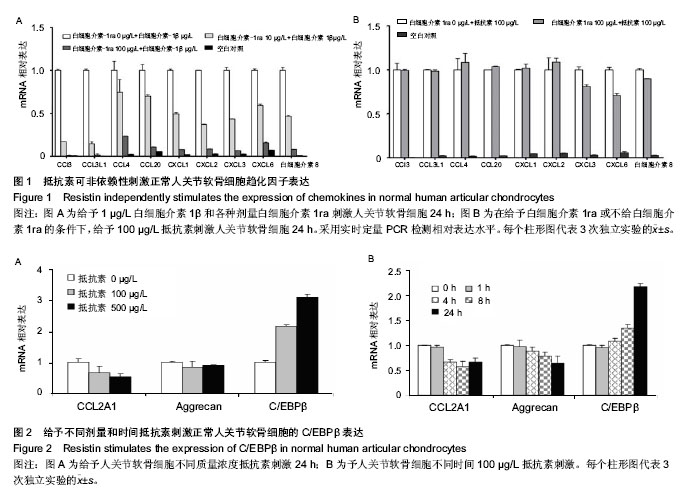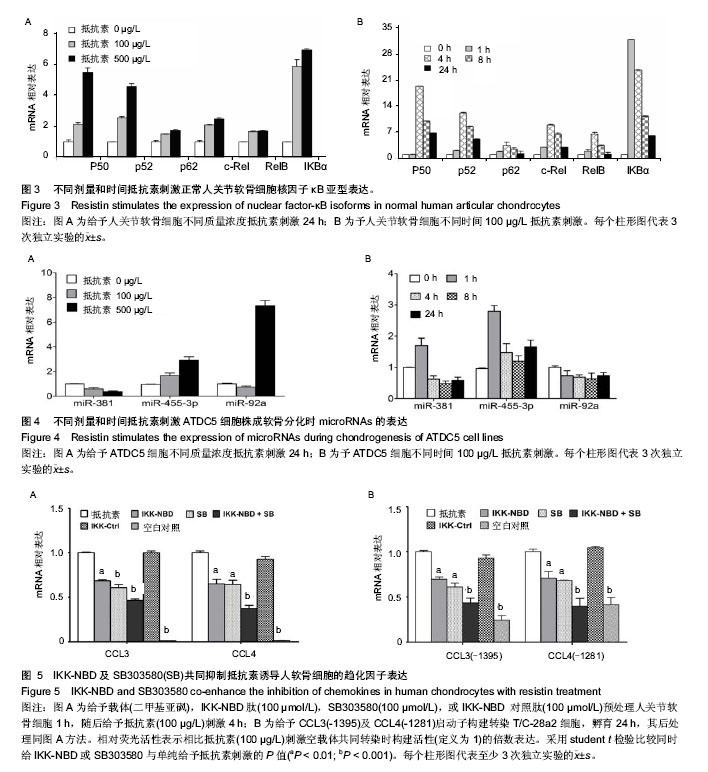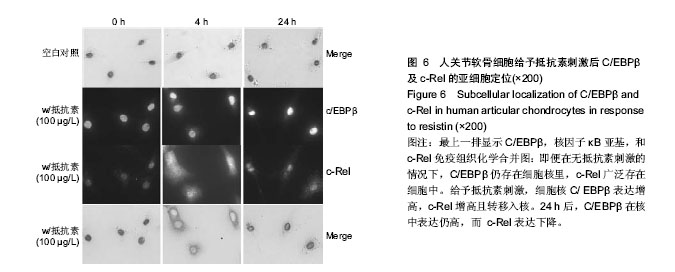| [1] Lee JH, Ort T, Ma K,et al.Resistin is elevated following traumatic joint injury and causes matrix degradation and release of inflammatory cytokines from articular cartilage in vitro. Osteoarthritis Cartilage.2009; 17:613-620.
[2] Schaffler A, Ehling A, Neumann E,et al. Adipocytokines in synovial fluid. JAMA. 2003; 290: 1709-1710.
[3] Senolt L, Housa D, Vernerova Z,et al. Resistin in rheumatoid arthritis synovial tissue, synovial fluid and serum. Ann Rheum Dis.2007; 66: 458-463.
[4] Presle N,Pottie P,Dumond H,et al.Differential distribution of adipokines between serum and synovial fluid in patients with osteoarthritis: contribution of joint tissues to their articular production. Osteoarthritis Cartilage.2006; 14: 690-695.
[5] Tilg H,Moschen AR.Adipocytokines: mediators linking adipose tissue, inflammation and immunity. Nat Rev Immunol. 2006; 6: 772-783.
[6] Koerner A, Kratzsch J, Kiess W.Adipocytokines: leptin-the classical, resistin-the controversical, adiponectin-he promising, and more to come. Best Pract Res Clin Endocrinol Metab.2005; 19: 525-546.
[7] Bokarewa M, Nagaev I, Dahlberg L,et al. Resistin, an adipokine with potent proinflammatory properties. J Immunol. 2005; 174: 5789-5795.
[8] Zhang Z,Xing X,Hensley G, et al. Resistin induces expression of proinflammatory cytokines and chemokines in human articular chondrocytes via transcription and messenger RNA stabilization. Arthritis Rheum.2010; 62: 1993-2003.
[9] Imamura T,Imamura C,McAlinden A,et al.A novel tumor necrosis factor α-responsive CCA AT/enhancer binding protein site regulates expression of the cartilage-derived retinoic acid-sensitive protein gene in cartilage. Arthritis Rheum 2008; 58: 1366-1376.
[10] Gerard C, Rollins BJ. Chemokines and disease. Nat Immunol. 2001; 2: 108-115.
[11] Goldring MB, Goldring SR. Osteoarthritis. J Cell Physiol.2007; 213: 626-634.
[12] Haringman JJ, Ludikhuize J, Tak PP. Chemokines in joint disease: the key to inflammation? Ann Rheum Dis.2004; 63: 1186-1194.
[13] Sandell LJ, Xing X, Franz C, et al. Exuberant expression of chemokine genes by adult human articular chondrocytes in response to IL-1.Osteoarthritis Cartilage.2008; 16:1560-1571.
[14] Zhang Z, Bryan JL, DeLassus E, et al. CCAAT/ enhancer-binding protein β and NF-κB mediate high level expression of chemokine genes CCL3 and CCL4 by human chondrocytes in response to IL-1β. J Biol Chem. 2010; 285: 33092-33103.
[15] Hao S, Baltimore D. The stability of mRNA influences the temporal order of the induction of genes encoding inflammatory molecules. Nat Immunol.2009; 10: 281-288.
[16] Yan C, Wang Y, Shen XY,et al. MicroRNA regulation associated chondrogenesis of mouse MSCs grown on polyhydroxyalkanoates. Biomaterials.2011; 32: 6435-6444.
[17] Suomi S, Taipaleenmaki H, Seppanen A, et al. MicroRNAs regulate osteogenesis and chondrogenesis of mouse bone marrow stromal cells. Gene Regul Syst Bio.2008; 2: 177-191.
[18] Lin EA, Kong L, Bai XH,et al. miR-199a, a bone morphogenic protein 2-responsive MicroRNA, regulates chondrogenesis via direct targeting to Smad1. J Biol Chem. 2009; 284: 11326-11335.
[19] Carthew RW, Sontheimer EJ. Origins and mechanisms of miRNAs and siRNAs. Cell. 2009;136:642-655.
[20] Brennecke J, Hipfner DR, Stark A,et al. Bantam encodes a developmentally regulated microRNA that controls cell proliferation and regulates the proapoptotic gene hid in Drosophila. Cell.2003;113:25-36.
[21] Dostie J, Mourelatos Z, Yang M,et al. Numerous microRNPs in neuronal cells containing novel microRNAs. RNA.2003; 9: 180-186.
[22] Chen CZ, Li L, Lodish HF, et al. MicroRNAs modulate hematopoietic lineage differentiation. Science 2004; 303: 83-86.
[23] Kobayashi T, Lu J, Cobb BS, et al . Dicer-dependent pathways regulate chondrocyte prolif-eration and differentiation. Proc Natl Acad Sci USA 2008; 105: 1949-1954.
[24] Zhang Z, Kang Y, Zhang Z,et al. Expression of microRNAs during chondrogenesis of human adipose-derived stem cells. Osteoarthritis Cartilage.2012;20:1638-1646.
[25] Choi SJ, Oba T, Callander NS,et al. AML-1A and AML-1B regulation of MIP-1alpha expression in multiple myeloma. Blood 2003; 101: 3778-3783.
[26] Tseng PC, Hsu HC, Janmanchi D,et al. Helioxanthin inhibits interleukin-1 beta-induced MIP-1 beta production by reduction of c-jun expression and binding of the c-jun/CREB1 complex to the AP-1/CRE site of the MIP-1 beta promoter in Huh7 cells. Biochem Pharmacol 2008; 76: 1121-1133.
[27] Otero JE, Dai S, Alhawagri MA,et al. IKKbeta activation is sufficient for RANK-independent osteoclast differentiation and osteolysis. J Bone Miner Res 2010; 25:1282-1294.
[28] He Y, Crouch E. Surfactant protein D gene regulation. Interactions among the conserved CCAAT/enhancer-binding protein elements. J Biol Chem 2002; 277: 19530-19537.
[29] Okazaki K, Yu H, Davies SR,et al. A promoter element of the CD-RAP gene is required for repression of gene expression in non-cartilage tissues in vitro and in vivo. J Cell Biochem.2006; 97:857-868.
[30] Chen L, Fink T, Zhang XY,et al. Quantitative transcriptional profiling of ATDC5 mouse progenitor cells during chondrogenesis. Differentiation.2005;73: 350-363.
[31] Venza I, Cucinotta M, Visalli M,et al. Pseudomonas aeruginosa induces interleukin-8 (IL-8) gene expression in human conjunctiva through the recruitment of both RelA and CCAAT/enhancer-binding protein beta to the IL-8 promoter. J Biol Chem.2009; 284: 4191-4199.
[32] Basak C, Pathak SK, Bhattacharyya A, et al. NF-kappaB- and C/EBPbeta-driven interleukin-1beta gene expression and PAK1-mediated caspase-1 activation play essential roles in interleukin-1beta release from Helicobacter pylori lipopolysaccharide-stimulated macrophages. J Biol Chem. 2005; 280: 4279-4288.
[33] Hirata M, Kugimiya F, Fukai A,et al.C/EBPbeta Promotes transition from proliferation to hypertrophic differentiation of chondrocytes through transactivation of p57. PLoS One.2009; 4: e4543.
[34] Esteves CL,Kelly V,Breton A,et al.Proinflammatory Cytokine Induction of 11β-Hydroxysteroid Dehydrogenase Type 1 (11β-HSD1) in Human Adipocytes Is Mediated by MEK, C/EBPβ, and NF-κB/RelA. J Clin Endocrinol Metab.2014; 99: E160-168.
[35] Rahman SM, Janssen RC, Choudhury M,et al. CCAAT/enhancer-binding protein β (C/EBPβ) expression regulates dietary-induced inflammation in macrophages and adipose tissue in mice. J Biol Chem.2012; 287: 34349-34360.
[36] Fukui N, Ikeda Y,Ohnuki T,et al.Pro-inflammatory cytokine tumor necrosis factor-alpha induces bone morphogenetic protein-2 in chondrocytes via mRNA stabilization and transcriptional up-regulation.J Biol Chem.2006; 281: 27229-27241.
[37] Tebo JM, Datta S, Kishore R,et al.Interleukin-1-mediated stabilization of mouse KC mRNA depends on sequences in both 5'- and 3'-untranslated regions. J Biol Chem.2000; 275: 12987-12993.
[38] Swingler TE, Wheeler G, Carmont V,et al. The expression and function of microRNAs in chondrogenesis and osteoarthritis. Arthritis Rheum.2012; 64: 1909-1919.
[39] Han J, Yang T, Gao J,et al . Speci fi c microRNA expression during chondrogenesis of human mesenchymal stem cells. Int J Mol Med.2010; 25: 377-384.
[40] Yan C, Wang Y, Shen XY,et al. MicroRNA regulation associated chondrogenesis of mouse MSCs grown on polyhydroxyalkanoates. Biomaterials.2011; 32: 6435-6444.
[41] Landgraf P, Rusu M, Sheridan R,et al. A mammalian microRNA expression atlas based on small RNA library sequencing. Cell 2007; 129: 1401-1414.
[42] Hummel R, Wang T, Watson DI,et al. Chemotherapy-induced modification of microRNA expression in esophageal cancer. Oncol Rep.2011; 26: 1011-1017.
[43] Moser JJ, Fritzler MJ. The microRNA and messengerRNA profile of the RNA-induced silencing complex in human primary astrocyte and astrocytoma cells. PLoS One. 2010; 5: e13445.
[44] Ujifuku K, Mitsutake N, Takakura S,et al. miR-195, miR-455-3p and miR-10a(*) are implicated in acquired temozolomide resistance in glioblastoma multiforme cells. Cancer Lett.2010; 296: 241-248. |



.jpg)
.jpg)